By Patrick Roefflaer
- Released: June 15, 1978
- Photographer: Howard Alk
- Photographer inner sleeve: Joel Bernstein
- Art-director: Tim Bryant and George Corsillo/Gribbitt
“How sexy he looks,” exclaimed my girlfriend, when she saw the cover of Street-Legal.
That was probably exactly the effect Bob Dylan had in mind with this photo. The man had just gotten a divorce and seems to be looking forward to the future. The title of the album also indicates this: street-legal is the term that indicates that a racing car has been modified, so that it is allowed on public roads.
The message is: Girls, I am a free man, waiting for you. The non-tanned line on his finger, where his wedding ring is missing, confirms his status as a bachelor.
The location of the cover photo
Generally it is stated that the photo of Dylan in front of the stairs is taken at the entrance of the studio where Street-Legal was recorded.
Rundown Studios is not actually a recording studio at all. Dylan rented the space in September 1977, for a five-year period. The building was built in 1960 and, like the rest of the neighborhood, looks a bit neglected. Hence the name “run down” (worn, tatty).
However, the location is ideal: it’s a half-hour drive from his home in Point Dume: a beautiful drive along the Pacific Coast Highway. Part of the 1,100 m² of available space is set up as offices. A large room is used as a rehearsal space for the planned tour.
Since Dylan is very committed to privacy, I have always found it strange that he would risk intrusive fans waiting for him, using a photo of his studio as a cover.
When the address of Rundown Studios (2219 Main Street, Santa Monica) is seen on Google Street View one will see an anonymous building. Parking is available on Main Street. Around the corner, on Strand Street, there is a double door entrance. At the rear there is a narrow outdoor space. However, nowhere can an access can be found with a staircase as seen on the cover. The steeply sloping footpath (better visible on the poster than on the cover itself) in particular seems to suggest a different location.
A possible explanation could be that the building has been demolished and replaced by a new building in the forty years that have now passed since Dylan rented it. I’ve found that Beach House CoWork is now at this location. The company rents custom office space. On their website they praise the space offered with the cry that the creative atmosphere of Bob Dylan still prevails. I received confirmation via email that it is still the original building.
Over the years I searched for more information. On some forums people suggested that the photo was taken in Australia (during the ’78 tour) or Malta (due to the Mediterranean atmosphere). Others began to explore the studio’s surroundings.
Following my post on the Expecting Rain forum, Bob Egan of Popspots, a website highlighting cover photo locations, received a photo of stairs in Santa Monica that is very similar. One Derek Brown from Glasgow had found it via Google Street View.
But because Bob Egan had done his own research, he knew this was not the right location. He advised Brown to start looking closer to the ocean, because the streets steeply rise from the beach. The simple search “staircase Santa Monica” was rewarded with a lucky return: the house at 26 Arcadia Terrace happened to be for sale.
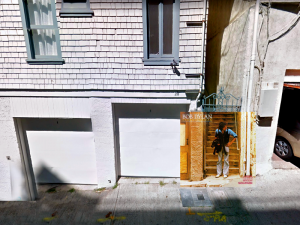 Through Street View Brown found the staircase in question, at the back of the house, near 2 Pacific Terrace. The location is just a 12 minute walk from Rundown Studios.
Through Street View Brown found the staircase in question, at the back of the house, near 2 Pacific Terrace. The location is just a 12 minute walk from Rundown Studios.
Many details are correct: the electricity box, the wooden shingles on the left, the double rainwater drains, the sewer cover in the footpath …
You can click the location here in Google Street view: https://tinyurl.com/y2boz3qt
Anyway, the photo is the work of Howard Alk, just like the one on the back: Dylan, wearing white make- up and dressed all in white, probably somewhere in Japan or Australia, during the 1978 tour.
Howard Alk
Howard Alk was a man of many trades. At the University of Chicago, he was mainly involved in cabaret. After his studies he was one of the co-founders of the successful improvisation theater The Second City.
He was also involved with The Film Group, a commercial film company that ran commercials as well as documentaries on jazz, blues or political subjects.
In 1963 he and Albert Grossman invested in a club: The Bear. To promote it, he drove through the streets of Chicago, on a motorcycle… dressed in a bear suit. The club opened on April 25, 1963, with a performance by one of Grossman’s upcoming talents: Bob Dylan.
Grossman also later arranged for Howard and his wife Jones to be on the guest list for Dylan’s 1965 British tour. In the credits for the documentary Don’t Look Back, Howard is referred to as an “assistant cameraman”. He also joined Dylan’s next British tour, this time as a photographer.
In the fall of 1966, Dylan asked him to help compile a documentary film from the images of D.A. Pennebaker made on that last tour. This would become Eat the Document.
They kept in touch and when Dylan wanted to make his own movie, during the Rolling Thunder Tour, he asked Howard Alk to film everything. In 1977 they spend a lot of time together in an small house on the grounds of Point Dume, to compose the film Renaldo and Clara.
Alk is also present at the rehearsals at Rundown Studios and the first part of the 1978 tour.
During the 1980 and 1981 tours, Dylan again called on Howard Alk to capture concerts on film.
After his second marriage broke down, Alk finds a place to stay in Rundown Studios. His body was found there on January 3, 1982 – he died of an overdose of heroin.
Joel Bernstein
In addition to the cardboard outer sleeve, the paper inner cover is embellished with two large black and white photos. Both are the work of Joel Bernstein.
In February 1969, Joni Mitchell performed for the first time at Carnegie Hall in New York. To take publicity photos of her, she invited a 17-year-old boy she met in California. Her manager, Elliott Roberts, is impressed by the result and asked the boy to join another one of his clients for a show at The Bitter End: Neil Young and Crazy Horse.
“I tuned his Martin D guitar in the Electric Factory. Three years later, I was a photographer on the Time Fades Away tour when he once asked to tune his guitars – and I was allowed to do that every night.”
Thus, almost unnoticed, he became a guitar technician, first only for Neil Young, then for Crosby and Nash and then for Dylan.
In 1976 Dylan proposed Bernstein to join him for the second part of the Rolling Thunder Revue. “I was the guitar technician on that tour,” he confirmed, “which meant responsible safety, tuning and setup of the guitars and all other stringed instruments (35 in all) for Bob and his band members for the entire tour from rehearsals in Clearwater to the last show in Salt Lake City.
I did the same for Bob on The Last Waltz and the 1978 Japan / Australia tour, from the auditions in Santa Monica in the fall of 1977 to the last show in Sydney.”
But he has not renounced his first hobby. At every opportunity he likes to take advantage of the proximity to the stars to take pictures both on and off the stage. “You are a fly on the wall,” he explains. “You disappear and you are focused on getting the perfect shot, so that later the viewer can see what it was like to be there. ”
His photos can be found on the covers of After the Gold Rush and Time Fades Away (Neil Young), Hejira (Joni Mitchell).
And also for Bob Dylan: “I am also a cover photographer and so I did the photo on the back cover of Hard Rain, the inside of Street-Legal, cover and poster of At Budokan and, I believe, a photo each in Biograph and the Bootleg Series Vol. 1-3. ”
The photos on the Street-Legal inner sleeve were taken in March 1978, at the hotel bar in Melbourne. The guitarist George Benson just happened to be there for a tour at the time and they were staying in the same hotel. Hence….
The other photo, of Dylan with Helena Springs, one of the singers from his band, was also taken during that period.
Later Bernstein became Prince’s permanent guitar technician, but mainly archivist for Neil Young. He spent no less than 19 years “and one day!” on the box set Neil Young Archives Vol. 1 1963-1972.
Album Design
Since Dylan has moved to the West Coast, he no longer calls on John Berg, the art director for Columbia Records in New York. The Los Angeles department proposes Dylan to work with one of the designers they rely on: Gribbitt!, an “Art direction & graphic design company” located at Sunset Boulevard, Hollywood.
The agency is headed by Tim Bryant, who makes the main designs, but he leaves the finish to his new assistant: George Corsillo. Corsillo just arrived from New York, where he spent three years working for a book cover company. His first album cover was an instant hit: the Grease soundtrack (April 1978). Street-Legal therefore followed very shortly afterwards.
Emmett Grogan
Finally, it is remarkable and unusual that Dylan dedicated the record to someone.
Emmett Grogan is a 35-year-old man who was found dead on the New York City Subway on April 6, 1978 – an overdose of heroin.
Dylan fans mainly associate his name with the Emmett Grogan acetates, which have appeared on numerous bootlegs. They are raw mono mixes of songs recorded during the sessions for Another Side of Bob Dylan and Highway 61 Revisited sessions. Grogan received the songs on six acetates from Dylan, during a meeting in 1966. Grogan said afterwards that: “Bob Dylan is exactly as I had not imagined him.”
Grogan was the ultimate hippie warrior, combining Dada street theater with revolutionary political ideas where he saw everything for free. His autobiography Ringolevio: A Life Played for Keeps (1972) paints a romanticized picture of his life.
Previously published…
- The story of the art work on Bringing it All Back Home
- The untold story of the artwork on Bob Dylan’s Greatest Hits
- The Sleeve Art of Bob Dylan’s album: “Bob Dylan”
- The Sleeve Art of Bob Dylan’s Album: Slow Train Coming
- The Freewheelin’ Bob Dylan – the untold story of the artwork of the album
- Times they are a changin’: the album artwork
- The art work on Bob Dylan’s albums: The Basement Tapes
- The source of the artwork of “Another side of Bob Dylan”
- The art work on Bob Dylan’s “Infidels”: what’s in a name?
- The art work of Nashville Skyline
- Absolute Exclusive: Empire Burlesque and Biograph artwork
- The artwork to Knocked Out Loaded
- The Art Work of the Traveling Wilburys Vol 1 (guest visitor, Michael Palin)
Untold Dylan: who we are what we do
Untold Dylan is written by people who want to write for Untold Dylan. It is simply a forum for those interested in the work of the most famous, influential and recognised popular musician and poet of our era, to read about, listen to and express their thoughts on, his lyrics and music.
We welcome articles, contributions and ideas from all our readers. Sadly no one gets paid, but if you are published here, your work will be read by a fairly large number of people across the world, ranging from fans to academics. If you have an idea, or a finished piece send it as a Word file to Tony@schools.co.uk with a note saying that it is for publication on Untold Dylan.
We also have a very lively discussion group “Untold Dylan” on Facebook with around 7000 active members. Just type the phrase “Untold Dylan” in, on your Facebook page or follow this link
You’ll find some notes about our latest posts arranged by themes and subjects on the home page of this site. You can also see details of our main sections on this site at the top of this page under the picture. Not every index is complete but I do my best. Tony Attwood

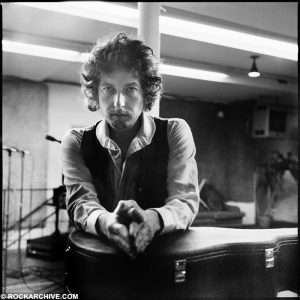
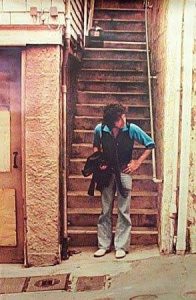
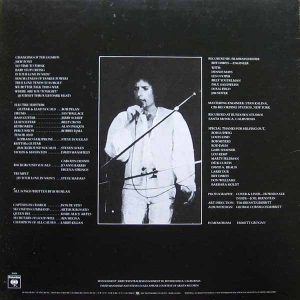
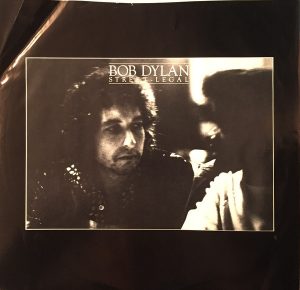
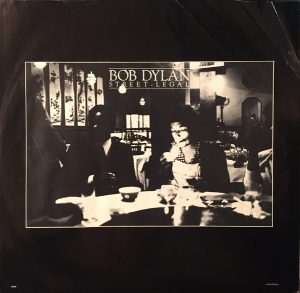
This has been one of my favorite album covers. If I weren’t broke, I’d travel to Santa Monica just to have my photo taken at that staircase. Now let’s figure out the location of the “Under the Red Sky” cover photo.
yeah, there’s no staircase shown at the property you’ve superimposed the cover on, just a gap between the buildings. the property next door up the street has a staircase though, so why not that one? I don’t get it.
Carl: Just as performers may record a song in various ways to find the right version, so it is common to take lots of pictures looking for the right pose of the album. The pic of Dylan with hand on hip looking to his left obviously felt interesting, but someone said, “I don’t like the background though.” In the pre-digital days they might have forced the performer to take up the same pose in another location, but with Dylan probably off touring by then, they couldn’t, so they placed a new background around him.
These things are often not planned in advance but rather the result of discussions over the pics that they have got, and then trying to make the most out of them.
I’d call the result iconic – it is certainly a cover I always remember.
Sexy- “ …was probably exactly the effect Bob Dylan had in mind with this photo.” really?
One thing Bob Dylan has never had to Do is try to project sexy for an “effect” – the man just is. You can almost see steam emanating from his core. Just saying. Lol.
Carl, there is a staircase there, you just can’t see it because of the angle and the fact there is now a gate there. Some local Dylan fan needs to go there and take a more accurate photo.
Here’s a close up https://www.google.com/maps/place/2+Pacific+Terrace,+Santa+Monica,+CA+90401,+USA/@34.0094977,-118.4935978,3a,15y,350.29h,70.68t/data=!3m6!1e1!3m4!1seDTaPsEjydx6boyp3hCa8Q!2e0!7i16384!8i8192!4m5!3m4!1s0x80c2a4d6b8e2bf9b:0xee4628a4e491e368!8m2!3d34.0096468!4d-118.4935182
http://www.imagebam.com/image/a9fc0a1350483895
Derek, congrats on fnding the right spot for the photograph.
Thanks Patrick. Street Legal is one of my favs and I have always been intrigued by the cover and always hoped the location would be discovered one day, I just never thought I would be the one to find it, with the essential help of Bob Egan of course.
2619 Main Street (corner of Main @ Strand) was the correct location of Rundown Studios. From Aug1977 to Jul1978, I supplemented my recent accounting-to-carpentry career-break new framing carpentry day job (Hohman Construction Co., Santa Monica CA) with an evening job delivering pizza for Quattro’s Pizza (Santa Monica pedestrian plaza @ Santa Monica Blvd.); te reason for multiple jobs was due to my having taken a significant cut in pay, with the job change. One evening, circa Feb1978, I delivered pizza to 2619 Main Street, parking my VW bug in the building’s parking lot (Main @ Strand). Being a long-time folk music fanatic, and Dylan fan, I had heard/read that Bob was working on an album somewhere in Southern California, if not Santa Monica. I rang the doorbell, no one answered, the door was unlocked so I entered the building’s ground floor foyer. Mind you…I had no idea who resided in the building, or who the owner(s)/tenant(s)/business entity occupants might be. In the foyer, I punches a buzzer, and began looking at the walls; the walls had several posters related to Dyla’s albums and his “Renaldo & Clara” then-recently published movie. A young man descended the stairs, or invited me up the stairs…this was 47 years ago, I can’t recall exactly. The reason I mention possibly being upstairs is that I entered a room that had a pool table and video machines. Something indicated I was in/near a recording studio (quiet signs, maybe, etc.). The young man paid the pizza bill, and I asked “…could this be where Bob Dylan is recording his current album project?…”. The young man smiled and attempted a verbal dodge of my question, so I did not push the matter further. I sensed that he had been warned against publicizing the activities within the building, and I was fine with that, said good-bye, and exited. Within weeks or a few months, Dylan’s “Street Legal” album was in my favorite record store’s bins, and I read the liner notes, immediately learning that the unmarked Main @ Strand building, to which I had delivered pizza, weeks previously, was in fact Dylan’s rented studio space, and that its Dylan-christened name (unless someone else had named it) was “Rundown Studios.” The young man who paid me for the pizza was probably one of the recording engineers. Moral: Take a supplemental night gig to help pay th’ rent, and find yourself accidentally bumping randomly into the shadow of celebrity. —Dan Drew, CPA, Walnut Creek California
Great story Dan. Thanks for sending it in.